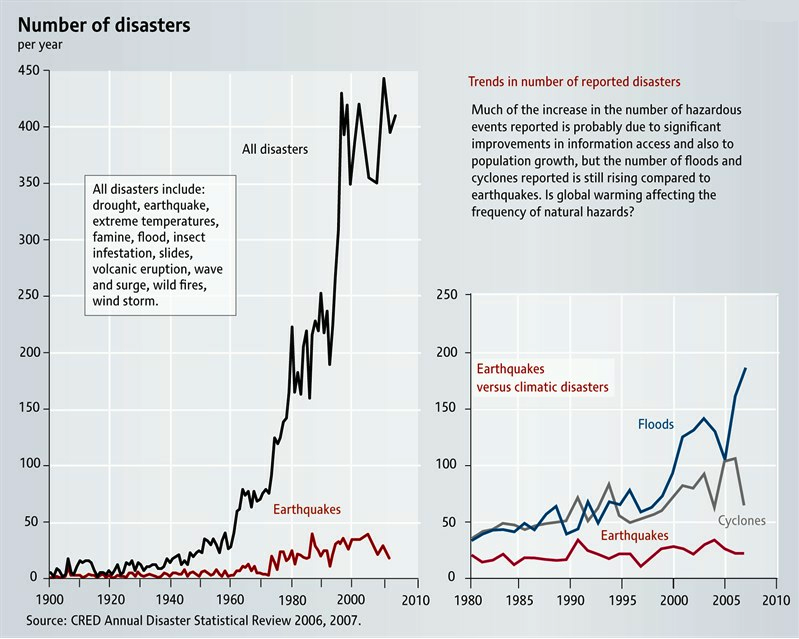At Invested Development, we frequently herald the impact that mobile technology can create for the underserved in their daily lives. Mobile technology, specifically information and communication services, has also dramatically increased the effectiveness of disaster relief services. Having access to information and communication greatly helps those affected by natural disaster and those who are trying to help. There is an opportunity for innovation to increase the impact that ICT and mobile technology has on people affected by natural disasters. To better understand this opportunity for impact, we researched the frequency of disasters, the role of technology, and how aid organizations are responding.
More Frequent Disasters
Natural disasters are occurring more frequently and in vulnerable areas, with Asia oft cited as the hardest hit region. The costs of recovery are high and also rising. “In the last decade, average annual disaster costs have been $67 billion. This is a 14-fold increase since the 1950s.” (Guha-Sapir, Hargitt, & Hoyois, 2004). Population growth and urbanization are a part of the rising costs, but there have also been more reported disasters in recent years: there was an average of 200 reported disasters per year twenty years ago, while today, there is an average of 400 per year (Halff, 2011). The effects are widespread In 2010, 45 million people were forced to flee during 2010 because of sudden-onset natural disasters (Halff, 2011).

Success Stories: Technology in Disaster Relief
Given the increasing frequency of natural disasters and our growing population, disaster response must be effective. In the past few years, many ICT and mobile technology innovations have greatly increased the effectiveness of disaster relief, allowing affected people to get the help they need, faster. The availability of such technology has also increased global awareness and better reporting.
The following are examples of technologies that have made a significant impact on the effectiveness of aid response:
Ushahidi. The innovative open source model allows people to contribute and crowdsource information in times of crisis. People can simply send a message or update to Ushahidi; the platform organizes it into timelines, interactive maps, and information visualization related to events and disasters. Ushahidi provides real-time information and disseminates it quickly and accurately.
Voila and the IFRC. The IFRC worked with Voila to create an SMS application that targets phones based on their location. After the Haitian earthquake struck in January 2010, the application sent 1+million SMS messages daily “containing information in Creole about emergency treatment, vaccinations, and other IFRC programs.” (Zuckerman, 2011). The application was also able to send out emergency weather warnings relevant to the recipient’s location. This kept the people informed and aware of the services available to them.
Haitian Mobile Money Initiative. The Bill and Melinda Gates Foundation and USAID funded a $10 million program to initiate mobile financial services in Haiti after the earthquake. The goal was to use mobile money to accelerate Haiti’s recovery by enabling the flow of financial resources among family, friends, humanitarian agencies, charities, and donors.
Relief Labs International. With offerings based entirely on technology, Relief Labs aims to address the ongoing needs and inefficiencies within aid and relief organizations. aidReg, for example, is an online registry that allows responders to organize the flow of goods and coordinate what items are needed into disaster zones. This highly increases the effectiveness of any disaster response by ensuring that supplies go where they are most needed.
Red Cross Family Links. After the Japanese tsunami and disaster, people were able to locate their family members and find the status of their well being online. The most important concern during a time of disaster is the safety of loved ones, and Family Links alleviated that concern for many.
Mercy Corps. As one of the most effective disaster response organizations in the world, Mercy Corps is focusing on mobile and development deployments in developing markets to increase disaster preparedness and resolution.
Increasing Expenditure
Seeing the impact that mobile technology has on increasing the efficiency, aid and humanitarian organizations are actively sourcing new solutions and innovations for their strategy. Organizations like the United Nations Refugee Agency (UNHCR) deploy relief services around the world with an increasing dependence on technology to manage the services. In our research, we found that their expenditure is increasing, particularly on mobile technology for information and communication services.
- Overall, “UNHCR was launched on a shoestring annual budget of US$300,000 in 1950. As its work and size have grown, UNHCR’s expenditure has soared. Its annual budget rose to more than US$1 billion in the early 1990s and reached a record US$3 billion in 2010, compared to US$1.8 billion in 2008,” (UNHCR, 2012).
- We looked through UNHCR’s annual reports to understand what portion of the budget goes to mobile technology for communication and information services. UNHCR has reported lined items for communication technologies in the last two years in their annual reports, which they hadn’t done in years before. In 2010, the UNHCR spent over $1.5 million on telecommunications alone.
The Opportunity for Impact
Today there are more disasters, more people affected, and more money designated for disaster relief and innovation in technology to help. We’d like to see innovators and social entrepreneurs step up and expand the way technology is used for impact. There’s no shortage of demand for technology solutions, and there are aid organizations and impact investors who are willing and able to provide insight and funding. We can’t make disasters stop happening, but we can change the way they affect the vulnerable with the use of mobile technology.
Sources:
Halff, Kate. (2011). Press Release. IDMC. http://www.internal-displacement.org/8025708F004BE3B1/(httpInfoFiles)/3D76B7DE0E98B377C12578A7002CB49D/$file/PR_IDMC_climate-change_2011.pdf
Guha-Sapir, D., D. Hargitt, and P. Hoyois. (2004). Thirty Years of Natural Disasters 1974-2003: The Numbers. Centre for Research on the Epidemiology and Disasters: Belgium. http://www.emdat.be/old/Documents/Publications/publication_2004_emdat.pdf
“Number of Disasters per Year.” (2009). UNEP. http://www.grida.no/graphicslib/detail/number-of-disasters-per-year_1408
UNHCR. (2006-2010). Annual Global Report. http://www.unhcr.org/pages/49c3646c1a.html
UNHCR. (2012). “Financial Figures.” http://www.unhcr.org/pages/49c3646c1a.html
Zuckerman, Jocelyn C. (10 February, 2011). “How Tech is Helping the Haiti Recovery.” Fast Company. http://www.fastcompany.com/magazine/152/out-of-the-rubble-into-the-lab.html
New here?
- Follow us on Twitter.
- Like us on Facebook.
- Join us on LinkedIn.
- Sign up for our mailing list.
- Got an alternative energy or mobile tech startup for emerging markets? Apply.
- Catch up on past Weekly Reviews.
